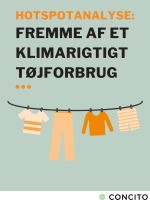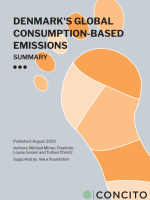Promoting climate-friendly consumption of clothing
The thinktank Hot or Cool conservatively estimates that the ‘fashion industry’ contributes with 4 percent of the global greenhouse gas emissions. The uncertainties and significant variations are linked to the many different measurements and calculation methods, as well as data points used. Nonetheless, some general statements can still be made about the climate and environmental impact of the textile production.
Production of textiles and clothing has a big climate impact as well as a substantial resource and land use. Different materials have different climate and environmental impacts, and some might have a large climate impact but a small environmental impact, and vice versa.
The volume, usage, and disposal patterns (including the frequency with which we buy and dispose of our clothes) are of great significance for the overall climate impact. Climate impact measured per unit such as CO2e per kg woven textile is therefore not indicative of clothing’s climate impact or the general trend in the overall climate impact from textile and clothing.
The quality and durability of textiles is central – but also a complex matter. Technical durability is not the same as emotional and aesthetic durability, and design and production practices that rely on a rapid and linear turnover, as well as “planned expiration”, are common in the textile and clothing industry. These practices contribute to rapid emotional and aesthetic expiration which leads to clothing often end up in waste streams before they are technically expired.
Therefore, CONCITO recommends that the industry’s business models change to no longer rely on large-volume production and sales of cheap clothes. At the same time, our recommendation revolves around facilitating opportunities for consumption that transition from consuming a lot of often poor-quality clothes to consuming less clothes of significantly better quality.
The current regulatory efforts in the field are however mainly focused on streamlining material flows and create space for recycling-based circularity, although these efforts do not necessarily lead to the necessary reduction in quantities and speed throughout the entire system. It is crucial that the authorities expand and to some extent change their foci, as the authorities play an important role for the focus and corresponding spaces for action established along the value chain.
This hotspot analysis therefore concludes with a number of recommendations for how to promote 1) regulation and legislation that contributes to a reduction in volume as well as extending the use phase, and 2) measures that ensure strong circularity (direct reuse) rather than weak circularity (solely recycling).
Overall, CONCITO recommends that EU in the upcoming textile strategy prioritize initiatives that support extended producer responsibility alongside targeted producer responsibility, as well as a ban on the destruction of unsold clothes (red: this ban has been implemented). Denmark should as a minimum support these initiatives, supplemented with initiatives that limit the marketing of new and cheap clothes. Finally, the textile industry is encouraged to transition to circular business models, inspired by the doughnut economy, and the consumers should limit their purchases of new clothes, prioritize high quality ‘favorite clothes’, and preferably second-hand clothes.





